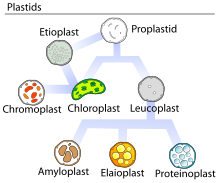Amyloplast: Difference between revisions
m Reverting possible vandalism by 218.186.12.228 to version by Discospinster. False positive? Report it. Thanks, ClueBot. (528155) (Bot) |
Added link to Spanish version |
||
| Line 29: | Line 29: | ||
[[bg:Амилопласт]] |
[[bg:Амилопласт]] |
||
[[de:Amyloplast]] |
[[de:Amyloplast]] |
||
[[es:Amiloplasto]] |
|||
[[fr:Amyloplaste]] |
[[fr:Amyloplaste]] |
||
[[it:Amiloplasto]] |
[[it:Amiloplasto]] |
||
Revision as of 23:04, 22 January 2009

Amyloplasts (a specialized form of leucoplasts) are non-pigmented organelles found in plant cells responsible for the storage of amylopectin, a form of starch, through the polymerization of glucose. Amyloplasts also convert this starch into sugar, for when the plant needs energy. In the day, in plants, there is more sugar than starch present. At night, there is more starch than sugar present.
Large numbers of amyloplasts can be found in underground storage tissues of some plants, such as potato. Amyloplasts are derived from plastids, which are a specialized class of cellular organs. The plastids carry their own genome and are believed to be descendants of cyanobacteria (blue-green algae) which formed a symbiotic relationship with the eukaryotic cell.
In the root cap (a tissue at the tip of the root) some specialized amyloplasts are thought to be involved in the perception of gravity by the plant (gravitropism). These specialized amyloplasts can sediment according to the gravity vector and are called statoliths.
Compare

- Plastid
- Chloroplast and etioplast
- Chromoplast
- Leucoplast
- Amyloplast
- Elaioplast
- Proteinoplast
